
Soybean Diseases and their Management in Montana
In the last decade, there has been an increase in the number of growers experimenting with grain soybean in Montana. Most acreage is grown primarily under irrigated land, though a portion is grown under rainfed conditions, mainly in the eastern part of the state.
Last Updated: 04/22by Oscar Perez-Hernandez, PhD, Montana State University (MSU) Extension Plant Pathologist; Alan Dyer, MSU Professor of Plant Pathology; and Timothy Fine, former MSU Extension Agent in Richland County
THE HARVESTED SOYBEAN ACREAGE IN MONTANA IN 2017
was estimated at 10,685 (NASS, 2017). The counties with more than 500 cultivated acres were Richland, Valley, Big Horn, Roosevelt, and Treasure (Fig. 1). Other minor producing counties include Rosebud, Yellowstone, Gallatin, Blaine, Teton, and Ravalli.

Figure 1. Major soybean growing counties in Montana. Blue and yellow circles indicate counties with more and less than 500 acres, respectively. Source: NASS, 2017.
Diseases are not a current issue in soybean in Montana. However, as soybean acreage increases and as climatic changes bring about shorter, warmer winters and extreme droughts, the risk of disease increases. This is evidenced by an increased occurrence of soybean plant diseases in neighboring states. Eventually, soybean growers may need to know how to recognize diseases and how to manage them effectively. This guide is a general description of the symptoms, causes, and management of the major soybean biotic diseases that are more likely to occur and become problematic in Montana.
Seed, root and stem diseases
Seed, root and stem diseases are caused by soilborne pathogens. The most significant disease problems in soybean are caused by fungi and fungal-like organisms. A brief description of the top soybean seed, root and stem diseases is given below.
PYTHIUM DAMPING OFF
Symptoms: Symptoms can appear at pre-emergence or postemergence. In pre-emergence, the symptoms are rotting and disintegration of the seed or failure of the seed to germinate. In post-emergence, the symptoms appear as lesions and discoloration of roots, and early death of seedlings (Fig. 2). As the disease continues to progress, the roots will rot and disintegrate.

Figure 2. Damping off of soybean seedlings caused by Pythium sp. Photo by Martin Chilvers.
Causal agent and life cycle: Pythium damping off of soybean is caused by at least 27 species of Pythium: a genus of fungus-like pathogens similar to Phytophthora. These organisms can live in soil for up to 10 years in a viable form until conditions are favorable for infection. When soils are saturated, the pathogen produces swimming spores (zoospores) that infect the soybean root. Then the pathogen continues to grow inside the plant.
Management: Cultural practices, such as improving drainage in areas prone to flooding or planting in conditions that are not too wet, can help reduce the incidence and severity of Pythium damping off. Planting less susceptible varieties will also help reduce the disease. Rotation with non-host crops is limited because Pythium infects numerous plants. Fungicide seed treatments in fields with a history of the disease can effectively reduce the disease.
PHYTOPHTHORA ROOT AND STEM ROT
Symptoms: Symptoms of Phytophthora root and stem rot can be identified at all stages of plant development. Early in the growing season, seedlings can be infected and killed while in the ground or early after emergence. Once the plant emerges, symptoms include bruised and soft stems, rotted roots, and yellow or brown wilted and/or dying leaves. Late season symptoms include brown lesions on roots, rotting roots, and brown discoloration on stems extending up from the soil line (Fig. 3). As with early plant stage symptoms the leaves will yellow, wilt, and dry but typically stay attached to the plant. Generally, plants will die in patches throughout a field or in parts of rows.

Figure 3. Brown rotting of the soybean stems caused by P. sojae. Photo by Daren Mueller, Iowa State University.
Causal agent and life cycle: Phytophthora root rot is caused by the fungus-like pathogen Phytophthora sojae. The pathogen survives free in the soil or in crop residue as oospores. The oospores germinate in the spring when temperature is suitable to form other structures known as sporangia. Sporangia form on the surfaces of infected roots and can re-infect other roots. In wet or saturated soils, asexual spores known as zoospores are produced inside sporangia and they are released, thus perpetuating infections. Zoospores swim in water over short distances, but are disseminated primarily by movement of surface water. They infect seeds and roots of plants.
Management: The primary management tactic is planting soybean cultivars resistant to the pathogen (Rps genes). This is sometimes ineffective currently, as there are now races of the pathogen that can overcome the resistant genes. Planting varieties with stacked resistance genes or with genes that are not often overcome is recommended. Other management tactics consist of creating environments in the field that are not conducive to disease development, such as tiling to increase drainage so that soils do not remain saturated. Where disease has been identified previously, treated seed can also provide protection. Specific fungicides with active ingredients against oomycetes should be used.
SOYBEAN CYST NEMATODE (SCN)
Symptoms: The most common symptom of the SCN infection is yellowing or chlorosis of the soybean foliage (Fig. 4). Plant stunting can also be observed, especially in soil heavily-infested with SCN (Fig. 5). In certain environments, however, no visible symptoms are shown, though grain yield could be reduced up to 30%. In the field, chlorosis and stunting occur in patches with high nematode population densities. Signs of SCN can also be observed on the roots around 25 to 30 days after planting. This can be done by carefully removing plants from the soil and observing with the naked eye, the white-to-yellow lemon-shape females of SCN on the roots. The mature females are about 1/32-inch long.

Figure 4. Chlorotic patch in a soybean field caused by the soybean cyst nematode. Photo by Albert Tenuta, Ontario Ministry of Agriculture, Food and Rural Affairs, Bugwood.org #5605414

Figure 5. Small area of stunted soybean plants caused by the soybean cyst nematode. Photo by Paul Bachi, University of Kentucky Research and Education Center, Bugwood.org #5430023
Causal agent and life cycle: SCN (scientific name Heterodera glycines) is a microscopic roundworm-like organism (Fig. 6) that infects soybean roots. The nematode survives in the soil as a cyst (Fig. 7), which can contain several hundred eggs. Each egg contains an infectious juvenile nematode that will enter the root tissue following hatching. Once inside the root, the nematode establishes a permanent feeding site, where it undergoes three molts to adulthood. Adult male nematodes abandon the roots and no longer feed. Female nematodes, in contrast, continue to enlarge to a lemon-shape until they break through the root tissue. Females are fertilized by males and develop hundreds of nematode eggs inside their body in the course of several days. A portion of those eggs will be released outside their body in a gelatinous enclosure. As the female matures, its body wall hardens off, and it dies becoming what is known as a “cyst.” Eventually, the cysts fall off the roots and remain in the soil.

Figure 6. Juvenile of the SCN. Image by Jonathan D. Eisenback, Virginia Polytechnic Institute and State Univ. Bugwood.org #5442354

Figure 7. Cyst of the SCN. Image by Thomas Powers, University of Nebraska-Lincoln.
Management: At present, the most effective management practices for SCN in the U.S. are the use of SCN-resistant soybean varieties and rotation to non-host crops, mainly corn, wheat and other grass crops. In fields grown to soybean for the first time or in which SCN has not been reported, continuous sampling and scouting is recommended for opportune detection of the nematode presence. Early detection of SCN and determination of infestation levels are key towards successful management of this pathogen.
SUDDEN DEATH SYNDROME (SDS)
Symptoms: SDS symptoms and signs can be observed both on roots and leaves. On roots, principal symptoms are rotting of the tap and lateral roots. Internally, the root tissue will look gray to brown (Fig. 8). A bluish mold may also be present on the surface of the tap root, especially at late stages of disease development and when the soil is wet. On leaves, the first symptoms appear as small, chlorotic spots (Fig. 9A) that will develop into brown or necrotic blotches. However, the leaf veins will remain green (Fig. 9B). Eventually, the infected leaves will detach from petioles, leaving the plant completely defoliated.

Figure 8. Brown coloration of the internal soybean root tissue caused by Fusarium virguliforme. Photo by Tamra Jackson-Ziems and Kyle Broderick. UNL Extension.

Figure 9A.

Figure 9B. Initial foliar symptoms (A) and late foliar symptoms (B) of SDS in soybean. Photos by Daren Mueller, Iowa State University.
Causal agent and life cycle: SDS is caused by the soilborne fungus Fusarium virguliforme. This fungus infects roots of soybean seedlings, especially under wet soil conditions. The infection can be more severe when soybean plants have been entered by the SCN. As infected soybean plants reach vegetative and reproductive stages, the fungus produces a toxin that moves up to the leaves, causing the typical SDS symptoms. The fungus overwinters in the soil or in surface residue of soybean and corn crops.
Management: An effective and durable control measure for SDS is the use of soybean varieties with some level of SDS resistance. Other measures include: i) avoiding planting in fields with history of the disease; ii) avoiding early planting in wet conditions as to reduce the risk of disease infection and possible compaction problems due to machinery traffic; and iii) use of seed treatments. Rotation with corn is not an effective management strategy, as the pathogen is reported to survive in corn residue.
WHITE MOLD OR SCLEROTINIA STEM ROT
Symptoms: First symptoms of white mold typically start at or after flowering. They include stem lesions that upon development cause stems to become soft, discolored and covered with a characteristic cotton-white mold growth, which is the actual body of the fungus (Fig. 10). Leaves become grayish, wilted and eventually die, yet they remain attached to stems (Fig. 11). The fungus produces hard, black sclerotia on or inside of stems and pods that look like mouse droppings (Fig. 12). In the field, soybean plants killed by white mold can be scattered or in patches.

Figure 10. White mold on stem of a soybean plant. Photo by Daren Mueller, Bugwood.org #5465745
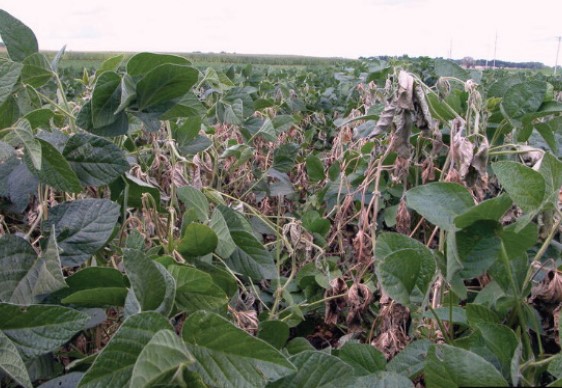
Figure 11. Wilting caused by Sclerotinia sclerotiorum in soybean. Photo by Craig Grau, Bugwood.org #5606015
Causal agent and life cycle: White mold, also known as Sclerotinia stem rot, is a widespread soybean disease caused by the fungus Sclerotinia sclerotiorum. The fungus survives in or on the soil as a hard, compacted mass of tissue known as sclerotium (sclerotia in plural; Fig. 13). When environmental conditions become favorable (abundant moisture and temperature between 40-60°F), the sclerotia germinate into small, cup-like structures known as apothecia (apothecium in singular; Fig. 13). Apothecia bear abundant spores called ascospores, which are disseminated by wind or rain to flowers, where infection is initiated. White mold is sporadic in some regions, but can be problematic in others, especially where the disease has previously occurred, weather is favorable for disease development, or where narrow row spacing and high plant populations have been used.
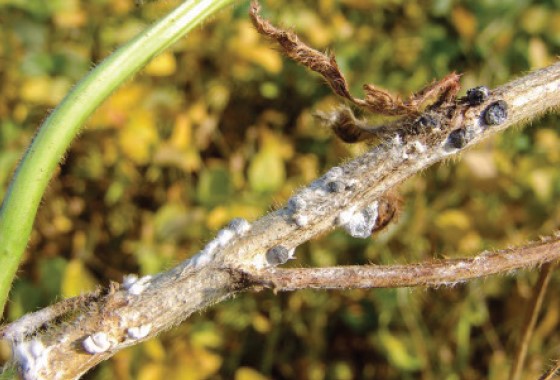
Figure 12A.
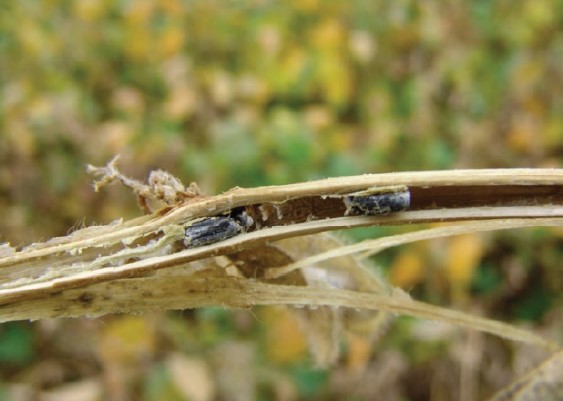
Figure 12B. Sclerotia of S. sclerotiorum formed on (A) and inside (B) soybean stems. Photo by Gerald Holmes, Strawberry Center, Cal. Poly San Luis Obispo, Bugwood.org #5609881 and 5609869.
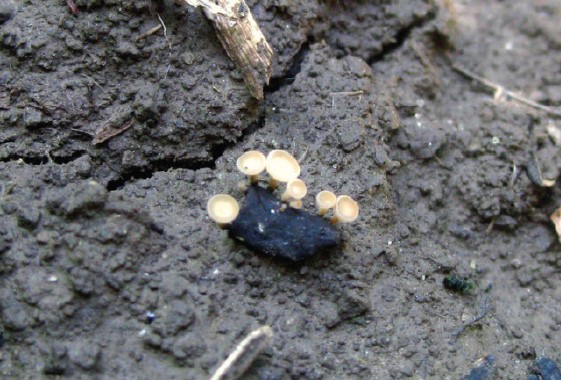
Figure 13. Apothecia emerging from a sclerotium of S. sclerotiorum. Photo by Craig Grau, Bugwood.org #5603987
Management: In-season practices for effective management of white mold are limited. Planting in wider rows and using low seeding rates can help reduce the severity of white mold by preventing an early plant canopy closure and therefore, conditions of high moisture in the canopy that favor disease development. Some foliar fungicides can work to control the disease. However, the applications need to be properly timed and repeated, and they may not be economically justifiable. To reduce risk of introducing sclerotia to non-infested fields during the harvesting period, it is recommended to harvest white mold-infested fields last. Cleaning the harvesting equipment thoroughly at the end of the season is also recommended to avoid introducing the pathogen to non-infested fields. Crop rotation and use of resistant varieties, though encouraged, are not feasible management practices to control white mold, because (i) the pathogen has a wide host range including corn and several broadleaved crops, and (ii) there are no developed soybean varieties with a high level of resistance to the pathogen.
RHIZOCTONIA ROOT AND STEM ROT
Symptoms: Rhizoctonia can cause seedling death at pre- and post-emergence. In pre-emergence, the symptoms are seed rot prior to germination or death of seedling. In post-emergence, plants will develop rusty-brown dry lesions on stems and roots near the soil line. Decay can occur on lateral roots. (Fig. 14A and B).
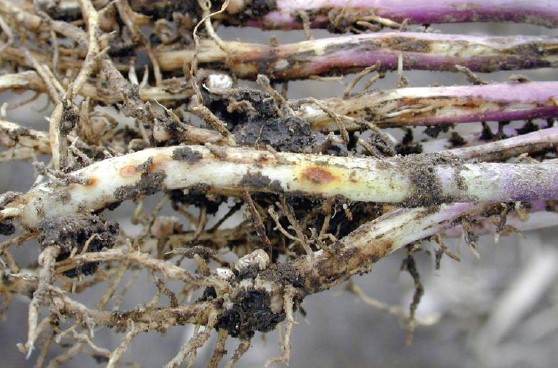
Figure 14A. Rhizoctonia damping off, blights and rots. Photo by Daren Mueller, Iowa State University. Bugwood.org #5466877.
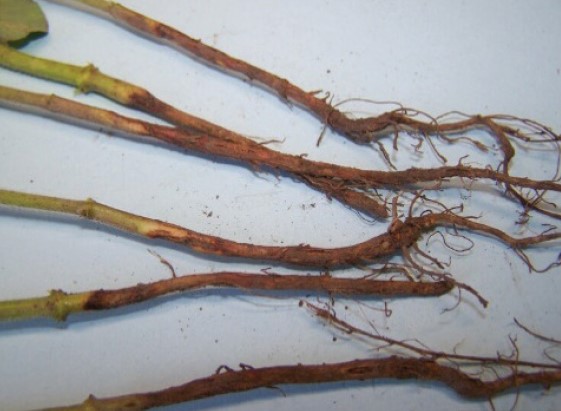
Figure 14B. Rusty-brown, dry lesions on stems and roots caused by Rhizoctonia. Photo by Carl Bradley, University of Kentucky, Bugwood.org #5604690
Causal agent and life cycle: Rhizoctonia root and stem rot is caused by the soilborne fungus Rhizoctonia solani. This pathogen has several strains known as anastomosis groups (AG). The groups that infect soybean are AG-2-2 and AG-4. Rhizoctonia survives in soil as sclerotia and lives on dead or decaying plant material. It can infect soybeans at any growth stage, though infection at early plant development is the main concern.
Management: Practices that limit plant stress should be employed as a cultural/preventative measure. Seed of high quality should be selected to limit pre-emergent disease problems. Fungicide seed treatments are also effective in preventing infection as seedlings get established.
CHARCOAL ROT
Symptoms: Symptom development is favored by abiotic stresses such as drought and high temperatures. In early infections, the disease symptoms are brown lesions on the hypocotyl, or stem, of seedlings. In later-season infections, the symptoms are browning and wilting of leaves and light gray streaks on the taproot and or lower stem. Symptoms generally appear at or after flowering, but plants also can be infected early in their development cycle (Fig. 15). The term charcoal rot comes from the appearance of small black specks that may appear inside the lower stem. When split open, there may also be reddish-brown discoloration within the vascular system.
Causal agent and life cycle: Charcoal rot is a fungal disease caused by the pathogen Macrophomina phaseolina. The fungus survives in soil or soybean residue as tiny hard structures known as microsclerotia that can last in soil for several years. These structures germinate early in the growing season and infect roots and stems. M. phaseolina can infect several plants other than soybeans. Infection occurs early in the growing season, but is not often observed until after flowering, and is far more severe and obvious during a hot and dry growing season.

Figure 15. Dead soybean plant patch caused by charcoal rot. Photo by Daren Mueller, Iowa State University.
Management: Management recommendations consist of keeping the soybean plants healthy and vigorous. Some varieties have shown some resistance to the disease but there are no varieties with complete resistance. Crop rotation works as a management strategy, but care should be taken to rotate to crops that are less susceptible, such as small grains. Growing small grains, such as wheat or barley, can reduce microsclerotia numbers. Because corn is a host, it will not reduce levels of the fungus when grown in rotation with soybeans. Fields with minimal or no tillage may have fewer symptoms because of lower soil temperatures and greater water-holding capacity. Avoid excessive seeding rates so that plants do not compete for moisture, which increases disease risk during a dry season. Foliar fungicides have shown to be ineffective to control the disease.
Foliar diseases
Foliar diseases are caused by the same group of pathogens that infect soybean roots. Some pathogens that cause foliar diseases survive in the soil or in plant debris. The most important foliar diseases of soybean are:
SEPTORIA BROWN SPOT (SBS)
Symptoms: Symptoms begin as small (less than 1/8 of inch) dark brown spots on the upper and lower surfaces of cotyledon and lower leaves of soybean plants early in the season (Fig. 16). As the infection progresses, the spots enlarge and grow together into irregularly-shaped dark or rusty areas; the entire leaf area where lesions develop becomes yellow or chlorotic (Fig. 17). New infections appear in upper leaves under favorable weather conditions, and can also develop on stems, pods and petioles. When the disease reaches high levels of severity, it can cause defoliation.
Causal agent and life cycle: SBS, also known as Septoria leaf spot, is an early-season disease caused by the fungus Septoria glycines. The fungus overwinters in soybean crop residue, from where it disseminates to healthy soybean plants by rain splash or wind. Infection is favored by high moisture and moderate temperature conditions. On infected leaves, the fungus develops fruiting bodies called pycnidia, which contain spores and can be seen with magnification as tiny, raised specks on the leaf surface.
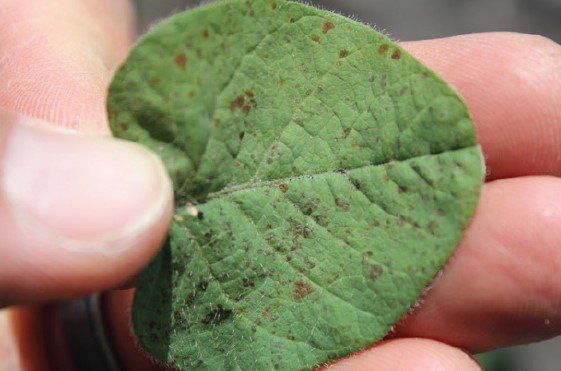
Figure 16. Septoria brown spot symptoms on a lower leaf of a soybean plant. Photo by Adam Sisson, Bugwood.org #5604276
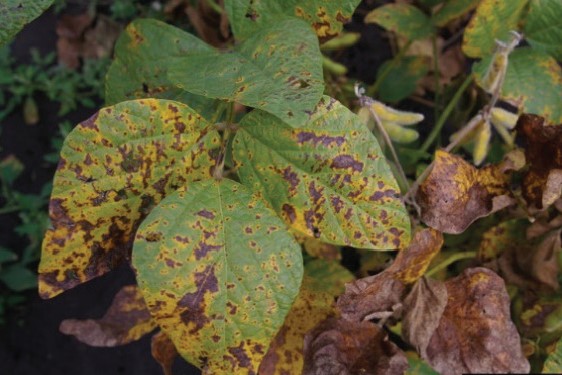
Figure 17. Septoria brown spot developed symptoms in soybean. Photo by Craig Grau, Bugwood.org #5604279
Management: SBS is normally not considered a disease of concern in soybean. However, under favorable conditions, it can inflict yield losses of up to 9%. Among the practices to manage the disease are rotation to non-legume crops and tillage to reduce the inoculum, and application of a foliar fungicide in conditions where there is a high risk of disease intensity to decrease infections. Genetic resistance is not a feasible option, as there are no soybean varieties with resistance to this disease.
FROGEYE LEAF SPOT (FLS)
Symptoms: The initial symptoms of FLS are tiny dark spots on leaves (Fig. 18), mainly in the upper plant canopy. The spots develop into brown lesions that eventually can reach diameters of about ¼ inch; the centers of these lesions become gray and the borders dark or reddish-purple (Fig. 19). Individual lesions can coalesce, forming irregular patterns of blighted areas of the leaf. In susceptible varieties, the lesions may cover more than 30% of the leaf surface and defoliation can occur. Lesions can also develop on stems and pods. On stems, the lesions are dark, long and narrow. On pods, the lesions are reddish-brown, round to elongate, and slightly sunken. The fungus can penetrate the pods and infect the seed, causing dark gray or brown areas that can range from specks to large blotches covering the entire seed coat. The seed coats of infected seeds often crack or flake. Like in foliar lesions, lesions in stems and pods can have centers that become gray.
Causal agent and life cycle: FLS is a late-season foliar disease of soybean caused by the fungus Cercospora sojina. The disease begins when the fungus’ spores on infested crop residue are carried by wind or rain to leaves of soybean plants. The spores infect the leaf tissue and eventually produce stalk-like structures that bear more spores out on the leaf surface. These spores are dispersed to healthy plants and cause further infections. Infection can occur at any stage of soybean growth, though it occurs more commonly after flowering. Development of FLS is favored by extended periods of warm, wet weather during the growing season. When the crop matures, the fungus remains in residue and overwinters as mycelium.
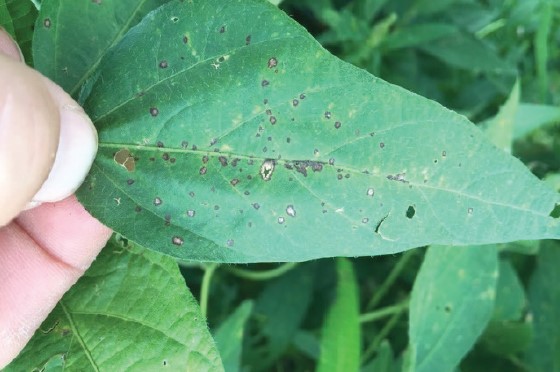
Figure. 18. Soybean leaf showing initial symptoms (tiny dark spots) of FLS. Photo by Adam Sisson, Bugwood.org # 5604628
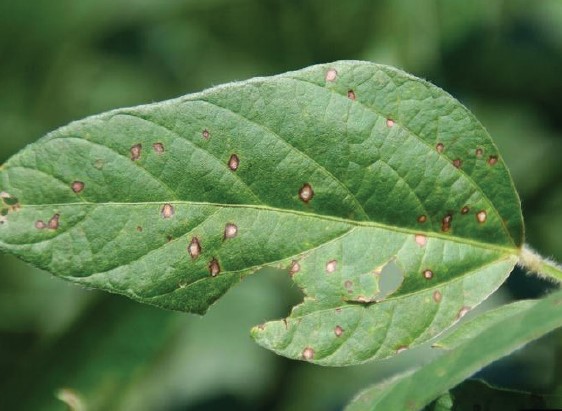
Figure 19. Soybean leaf showing mature or developed lesions (larger spots with clear center) of FLS. Photo by Daren Mueller, Iowa State University. Bugwood.org #5465827
Management: An integrated management of FLS should start with selection of soybean cultivars with a good level of resistance to the disease, as soybean cultivars vary in their response to FLS. Rotation with corn, wheat or any other non-host crop of the disease is a recommended practice to reduce the amount of inoculum in the field. Tillage to bury residue on which the fungus overwinters is another measure to reduce field inoculum levels. Fungicide applications at reproductive stage R3 can be effective in controlling FLS. However, attention should be paid to the use of Group 11 fungicides, the commonly known Strobilurins or Quinone Outside Inhibitors (QoI). Fungicides within this group were once highly effective to control FLS, yet, resistance of C. sojina to this class of fungicides has been documented in several regions of the U.S.
Other foliar diseases such as Asian soybean rust and Cercospora leaf blight and seed purple stain are problematic in southern areas and less problematic in northern areas of the U.S.
For additional information or more details on soybean diseases, refer to the following webpages:
- Crop Protection Network: https://cropprotectionnetwork.org/crops/soybeans
- Soybean diseases in North Dakota: https://www.ndsu.edu/pubweb/~bernelso/soydiseases/
- Soybean diseases in Minnesota: https://extension.umn.edu/soybean/soybean-pest-management
- Soybean diseases in South Dakota: https://extension.sdstate.edu/tags/soybean-diseases
- Soybean diseases in Wisconsin: https://fyi.extension.wisc.edu/fieldcroppathology/soybean_pests_diseases/
- Soybean diseases in Iowa: https://crops.extension.iastate.edu/soybean-diseases-symptoms-scouting-and-management
- Soybean diseases in Nebraska: https://cropwatch.unl.edu/plantdisease/soybean
Consult your local agriculture Extension agent or the row crop Extension Plant Pathologist at Montana State University, Oscar Perez-Hernandez, PhD, for additional questions about soybean diseases.

